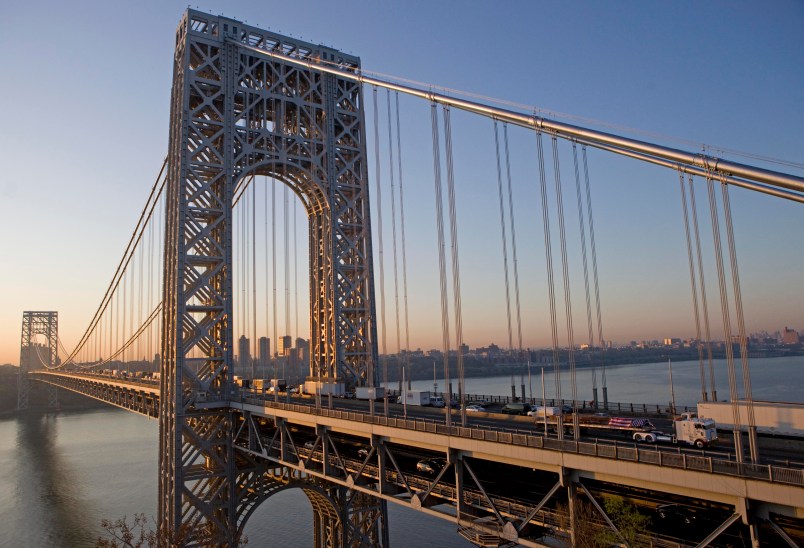Records obtained by TPM show George Washington Bridge traffic was a major factor in recent years as local officials and developers discussed a billion-dollar real estate project in Fort Lee, N.J.
In recent weeks, some have wondered whether the project was somehow linked to lane closures on the bridge in September, which snarled traffic for days in Fort Lee and have sparked multiple investigations into the administration of New Jersey Gov. Chris Christie (R).
The development project is a massive residential, retail and hotel development planned at the foot of the bridge. It consists of two parcels, Hudson Lights, which is being built by Tucker Development, and The Modern, a pair of residential towers proposed by Fort Lee Redevelopment Associates. Meeting minutes from the Fort Lee Planning Board show traffic on the bridge was often a topic of discussion and concern. Developers attempted to allay these fears by conducting multiple studies and simulations to analyze traffic patterns as they attempted to obtain approval for the project.
Late last year, two of Christie’s appointees at the Port Authority of New York and New Jersey resigned as questions mounted about the lane closures. The scandal then reached a boiling point last month as emails became public showing Christie staffers had communicated with the Port Authority officials about the closures ahead of time.
“Traffic signalization and coordination is a big issue with this project,” attorney James Demetrakis said at a Feb. 27, 2012 meeting. He was representing Fort Lee Redevelopment Associates.
The minutes obtained by TPM through a public records request showed a Port Authority official even met with Fort Lee’s mayor about the project and discussed potential solutions to “reduce traffic” near the bridge. On Tuesday, Fort Lee Mayor Mark Sokolich confirmed to TPM the Port Authority official was Bill Baroni, one of the Christie appointees who resigned last year amid the growing scandal.
In early 2012, the developers of the project presented multiple studies and an expert who assured city officials the project would not create a traffic problem for the bridge.
One study focused on the bridge’s “three toll booths that are dedicated to Fort Lee,” which are part of the very lanes that were later closed in the scandal. The study showed that during peak morning hours, the project would add about 160 vehicles to the bridge, which handles about 350,000 vehicles a day.
“Therefore, we will not be adding a significant amount of traffic to the bridge,” an engineer presented by one of the developers said.
But some planning board members remained skeptical. At a March 5, 2012 meeting, board member Janet Conney said her concern with the project was that it would potentially be “dumping vehicles directly onto the bridge.” The board’s chairman also said the board would be conducting its own “traffic evaluation” of both the retail and residential parts of the development.
When he spoke to TPM on Tuesday, Fort Lee Mayor Mark Sokolich said that he met with the Port Authority Deputy Executive Director Bill Baroni “maybe one, maybe two” times to discuss ways to reduce traffic. Sokolich said they talked about shuttle bus service, a potential bike share program and parking facilities for car poolers. He said the conversations did not reach a point where they were discussing adding toll booths or lanes to help local residents reach the bridge.
“We never got deep enough into it, we never really got that far to say we started getting into specifics,” Sokolich said.
However, Sokolich said that, based on his meetings, there was no way Baroni was unaware of the project. Baroni has said the lanes were shut as part of a traffic study to examine the impact of closing some of the lanes used by Fort Lee residents to access the bridge. Sokolich said, based on their meetings, Baroni could not have thought closing any of the lanes would have had a positive impact on Fort Lee.
“It would be impossible for him not to concede that and nor would he,” said Sokolich.
At a March 26, 2012 planning board meeting, Scott Parker, an engineer, presented reports about potential traffic at the development.
“I think that after this project is completed, the traffic at the George Washington Bridge will be tolerable,” Parker said.
The planning board gave its approval for part of the development at that meeting.
Approval for the rest of the development was granted at the June 11, 2012 meeting. Prior to that vote, Sokolich made remarks voicing his strong support for the development and its importance to him. It was a process, he said, that was three and a half years in the making.
“This community has placed a lot of faith in this development, and it is very important that this development go forward,” said Sokolich, according to the minutes. “I believe this project will bring very, very positive change to this borough. We are in the middle of making history here. This is going to be Fort Lee’s Renaissance. … This is the biggest thing for Fort Lee since the construction of the George Washington Bridge.”
Correction: This post has been updated to include the correct first name for James Demetrakis.






